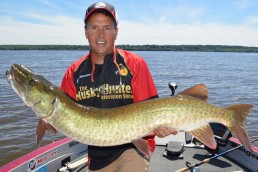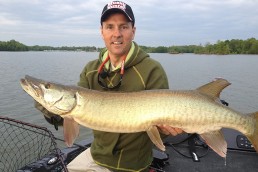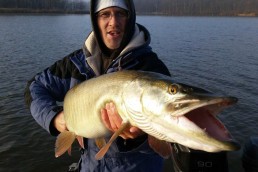Hook Up for Muskie
SHARE THIS POST
As muskie anglers, we generally pay a lot of attention to detail. After all, compared with bass and walleye anglers, the strikes we receive are often few and far between. However, the bites are bigger. We go to great lengths to purchase quality rods and reels, line, and leaders to make sure, when that big bite occurs, there are no mechanical failures. Bass and walleye anglers can get away with more when it comes to tackle, the next opportunity is just around the corner. As muskie anglers, we plan our trips, watch the moon charts, examine maps and discuss potential patterns and approaches in detail with our fishing partners. We even spend many late nights sharpening hooks to excess getting ready for when the big one strikes.
Of all of the details that we focus upon, I certainly believe the rods are the most important factor in landing muskies. There is no question that longer Shimano rods result in more muskies boated per strike than anything else in my boat. The longer rod lengths and high-performance action of the blanks just makes them better at fighting muskies and they help reduce human error. However, a close second in importance—yet something we really don’t focus on as often—are the hooks.
The right hook for your fish
Sure, we sharpen the hooks, but what about the actual hooks on the lure? We all have hundreds of muskie lures and pay an average of $25 each. Yet, how often do you look at the lure and say “the hooks are not right for that bait?” Many manufacturers believe the hooks they put on the lure they produce are adequate.
Depending on where and how you fish, the hooks the manufacturer places on the lure may not work for you! You often have to consider where the lure is made to examine if the hooks are the correct size, shape and thickness. For example, a lure manufacturer that is based in an area where there are lots of muskies which are smaller in size might prefer to produce their lures with smaller hooks. These smaller hooks will increase hooking percentages with smaller muskies.
If you fish in Minnesota and are targeting larger muskies, you might think the hooks are too small. You’re likely correct. You will need to change the hooks to a larger size. Likewise, a lure manufacturer from the Eastern US might put 7/0 hooks on a crankbait. Many of their clients are speed trolling and/or targeting muskies in the Great Lakes. If you are fishing a Midwestern shad-based reservoir, a hook that large is overkill. It may actually cost you muskies. In that case, you need to attach smaller hooks.
Hook size and thickness
The first thing to consider when examining a lure is hook size. Ask yourself, are the hooks too small or too large? Sometimes a lure with three smaller hooks can work better and hook muskies more efficiently by removing the three smaller hooks and replacing them with two hooks that are one size larger and attaching them to the front and rear of the lure. Hook size can dramatically increase lure action and hooking ability. So, don’t be afraid to experiment with hook size to maximize your results.
Are you enjoying this post?
You can be among the first to get the latest info on where to go, what to use and how to use it!
The second thing to consider regarding hooks is the hook thickness. Basically, are the hooks thick wire or thin wire? Unless you have a preference, my advice is to leave the hooks on the bait until you get a chance to test it in the water. If you lose a fish or two on the bait, change to thicker or thinner hooks. I have always said that, depending on how you fight a muskie, a thick or thin wire hook may be best for you. If you fight a muskie hard, thick wire hooks are best. If you tend to play the fish more during the fight, the thin wire hooks are better. Even if you know ahead of time if you prefer thick or thin wire hooks, test the bait in the water first with the original hooks so you can see what the lure is “supposed” to look like with the original hooks. You just don’t want to change the lure action too much. Like hook size, hook thickness can change the buoyancy of the lure.
Mind the gap
Finally, the last thing to consider regarding hooks is the hook gap. That’s the distance between the shank of the hook and the barb. The larger the gap, the wider the space between the shank and the hook barb. Generally, large-gap hooks are better when dealing with larger muskies. Their jaws are larger and the big gap increases your ability to get the hook deeper in the jaw or mouth to get a better hookset.
These large-gap hooks can be counterproductive with smaller fish. So, you might lose smaller fish with a hook gap that’s too big. Consider the typical muskie you encounter. If they are large, go with a wide gap. It they are smaller, go with a narrower gap. When I used to fish tournaments, I would select hooks that were lighter wire and had a narrower gap. Tournaments are often about boating multiple muskies between 36 and 40 inches. That style hook is most conducive to landing that size muskie.
We all dream about catching big muskies, however, we have to be realistic regarding the waters we are fishing. Not every water is loaded with giant fish. So, to increase your odds at maximizing your muskie season, consider the muskies you are chasing, the waters you are fishing, and select the right hook size and style that best suits the lure and the muskies that roam your waters. MWO
Jim Saric is a Legendary Angler in the Freshwater Fishing Hall of Fame, the host and executive producer of “The Musky Hunter” television series, editor at large of “Musky Hunter” magazine, a seven-time muskie tournament winner, and a contributing writer for numerous other publications.
MWO
SHARE THIS POST
Did you enjoy this post?
You can be among the first to get the latest info on where to go, what to use and how to use it!
Jim Saric
Jim Saric is a Legendary Angler in the Freshwater Fishing Hall of Fame, the host and executive producer of The Musky Hunter television series, editor at large of Musky Hunter magazine, a seven-time muskie tournament winner, and a contributing writer for numerous other publications.



